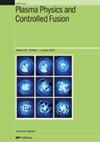通过 KSTAR 的贝叶斯神经网络加强干扰预测
IF 2.3
2区 物理与天体物理
Q2 PHYSICS, FLUIDS & PLASMAS
引用次数: 0
摘要
在本研究中,我们开发了一种基于贝叶斯深度概率学习的数据驱动型中断预测器,能够预测 KSTAR 中的中断并对不确定性进行建模。与频数主义方法中的传统神经网络不同,贝叶斯神经网络可以量化与其预测相关的不确定性,从而通过不确定性阈值降低误报率,提高中断预测的精度。利用来自 EFIT 和诊断数据的 0D 等离子参数,使用了善于处理多时间尺度数据的时序卷积网络。所提出的框架展示了预测破坏的能力,并通过在 KSTAR 实验数据中的成功应用证实了其有效性。本文章由计算机程序翻译,如有差异,请以英文原文为准。
Enhancing disruption prediction through Bayesian neural network in KSTAR
In this research, we develop a data-driven disruption predictor based on Bayesian deep probabilistic learning, capable of predicting disruptions and modeling uncertainty in KSTAR. Unlike conventional neural networks within a frequentist approach, Bayesian neural networks can quantify the uncertainty associated with their predictions, thereby enhancing the precision of disruption prediction by mitigating false alarm rates through uncertainty thresholding. Leveraging 0D plasma parameters from EFIT and diagnostic data, a temporal convolutional network adept at handling multi-time scale data was utilized. The proposed framework demonstrates proficiency in predicting disruptions, substantiating its effectiveness through successful applications to KSTAR experimental data.
求助全文
通过发布文献求助,成功后即可免费获取论文全文。
去求助
来源期刊

Plasma Physics and Controlled Fusion
物理-物理:核物理
CiteScore
4.50
自引率
13.60%
发文量
224
审稿时长
4.5 months
期刊介绍:
Plasma Physics and Controlled Fusion covers all aspects of the physics of hot, highly ionised plasmas. This includes results of current experimental and theoretical research on all aspects of the physics of high-temperature plasmas and of controlled nuclear fusion, including the basic phenomena in highly-ionised gases in the laboratory, in the ionosphere and in space, in magnetic-confinement and inertial-confinement fusion as well as related diagnostic methods.
Papers with a technological emphasis, for example in such topics as plasma control, fusion technology and diagnostics, are welcomed when the plasma physics is an integral part of the paper or when the technology is unique to plasma applications or new to the field of plasma physics. Papers on dusty plasma physics are welcome when there is a clear relevance to fusion.
 求助内容:
求助内容: 应助结果提醒方式:
应助结果提醒方式:


